1997 BUICK REGAL inflation pressure
[x] Cancel search: inflation pressurePage 3 of 422

Supplement to the 1997 Buick Regal and Century Owner’s Manuals
This is a correction to information found on page 6-40 (Regal only) and page 6-38 (Century only).
Inflation -- Tire Pressure
The Tire-Loading Information label, which is on the inside of the trunk lid shows the correct inflation
pressures for pur tires when they’re cold. “Cold” means your vehicle has been sitting for at least three
hours or driven no more than
1 mile (1.6 km).
This is a correction to information found
on page 6-63 (Regal only).
Engine Crankcase
Oil and Filter Change . . . . . . . . . . . . 4.5 quarts (4.2 L)
97REGWENOOl
1
ProCarManuals.com
Page 143 of 422

Tire Pressure Monitor Light
LOW
TI RE
The tire pressure monitor
system can alert you to
a
large change in the pressure
in
one tire. The system
won’t alert you before you
drive that a tire is low or
flat. Each time you start
your Buick, you must drive
10 to
20 miles (15 to 30 km)
before the system will
work properly.
After you’ve driven
10 to 20 miles (15 to 30 km), the
LOW TIRE light will come on if the pressure in one tire
becomes at least 10 psi
(69 kPa) higher or lower than the
other three tires. The tire pressure monitor system
detects differences in tire rotation speeds that are caused
by changes in tire pressure. It will not alert you
if the
pressure in more than one tire is low or high or
if the
system is not calibrated properly.
The system can alert
you about a low tire
-- but it doesn’t measure tire
pressure, and it doesn’t replace normal tire maintenance.
See “Tires’’
in the Index.
When the LOW TIRE light comes
on, you should stop
as soon as you can and check all your tires for damage. (If
a tire
is flat, see “If a Tire Goes Flat” in the Index.)
Also, check the tire pressure in all four tires as soon
as
you can. (See “Inflation - Tire Pressure” in the Index.)
The
LOW TIRE light will
stay on until you turn off
the ignition or press the red
RESET button, which is
located inside your
instrument panel fuse block.
(It’s the first button in
the
top row of the fuse block.)
Don’t press the RESET button without first checking
and adjusting the pressure in all four tires.
If you press
the button when the tire pressure is incorrect,
the check
tire pressure system will not work properly
and may
not alert you when a tire is low.
Any time
you adjust the tire pressure, you’ll need to
calibrate the check tire pressure system.
You’ll also neea
to calibrate the system whenever you buy new tires,
have tires repaired or rotate your tires.
ProCarManuals.com
Page 227 of 422
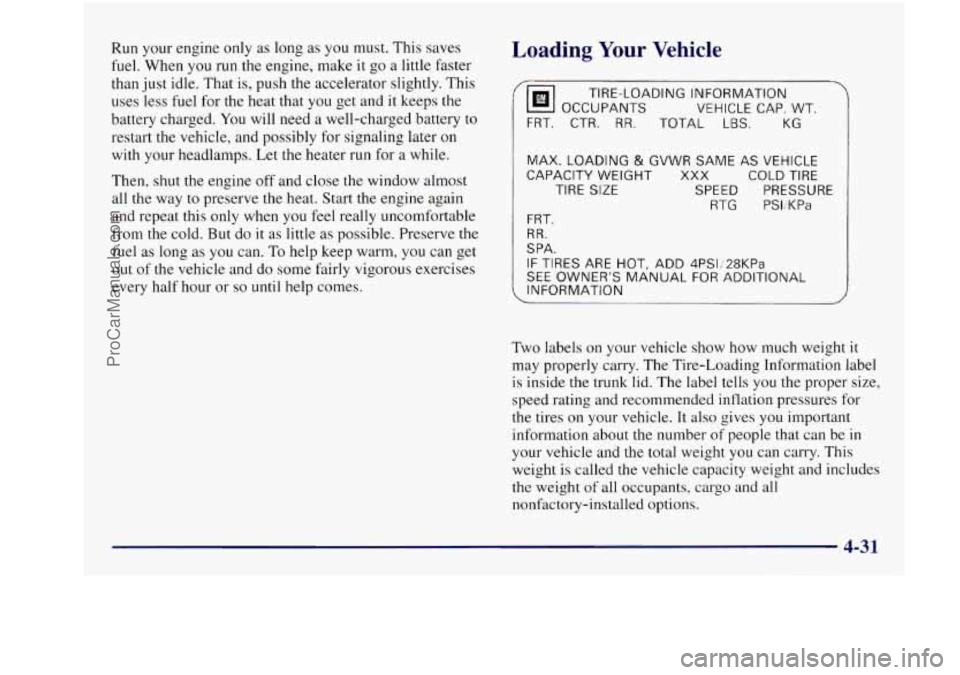
Run your engine only as long as you must. This saves
fuel. When you run the engine, make it go a little faster
than just idle. That is, push the accelerator slightly. This
uses less fuel for the heat that you get and it keeps the
battery charged. You will need a well-charged battery to
restart the vehicle, and possibly for signaling later on
with your headlamps. Let the heater run for a while.
Then, shut the engine off and close the window almost
all the way to preserve the heat. Start the engine again
and repeat this only when
you feel really uncomfortable
from the cold. But do
it as little as possible. Preserve the
fuel as long as you can.
To help keep warm, you can get
out of the vehicle and do some fairly vigorous exercises
every half hour or
so until help comes.
Loading Your Vehicle
OCCUPANTS VEHICLE CAP. WT.
TIRE-LOADING INFORMATION
FRT. CTR. RR. TOTAL LBS. KG
MAX. LOADING & GVWR SAME AS VEHICLE
CAPACITY WEIGHT XXX COLD TIRE
TIRE SIZE SPEED PRESSURE
RTG PSIlKPa
FRT.
RR.
SPA.
IF TIRES ARE HOT,
ADD 4PSIi28KPa
SEE OWNER’S MANUAL
FOR ADDITIONAL
, INFORMATION
Two labels on your vehicle show how much weight it
may properly carry. The Tire-Loading Information label
is inside the trunk lid. The label tells you the proper size,
speed rating and recommended inflation pressures for
the tires on your vehicle. It also gives you important
information about the number
of people that can be in
your vehicle and the total weight you can carry. This
weight is called the vehicle capacity weight and includes
the weight of all occupants, cargo and all
nonfactory-installed options.
4-31
ProCarManuals.com
Page 273 of 422
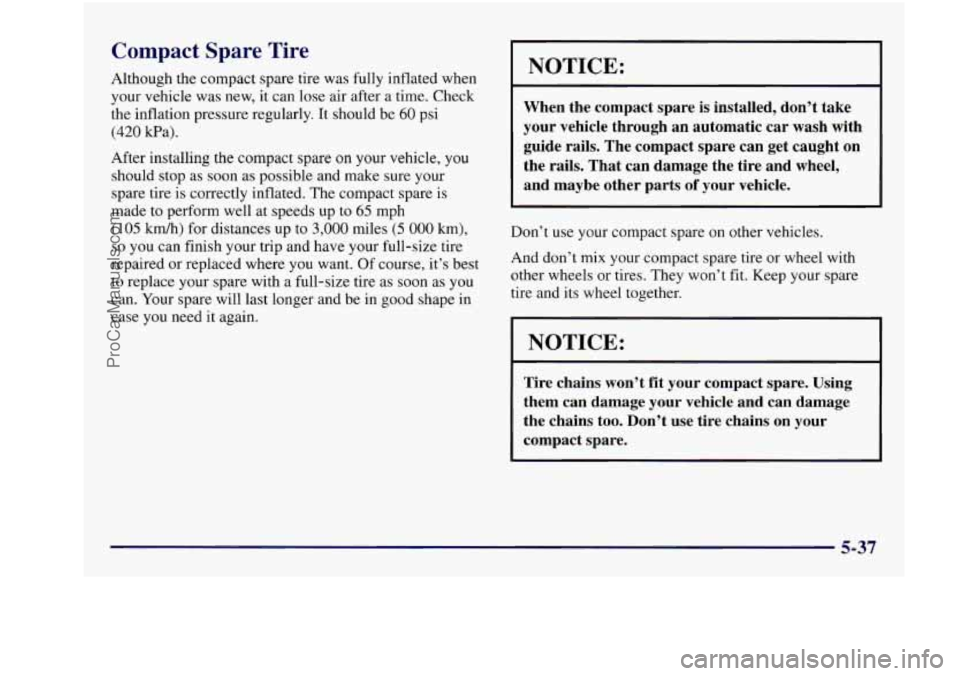
Compact Spare Tire
Although the compact spare tire was fully inflated when
your vehicle was new, it can lose air after a time. Check
the inflation pressure regularly. It should be
60 psi
(420 kPa).
After installing the compact spare
on your vehicle, you
should stop as soon as possible and make sure your
spare tire is correctly inflated. The compact spare is
made to perform well at speeds up to
65 mph
(105 kmh) for distances up to 3,000 miles (5 000 km),
so you can finish your trip and have your full-size tire
repaired or replaced where
you want. Of course, it’s best
to replace your spare with a full-size tire as soon as you
can. Your spare will last longer and be in good shape in
case you need it again.
NOTICE:
When the compact spare is installed, don’t take
your vehicle through an automatic car wash with
guide rails. The compact spare can get caught
on
the rails. That can damage the tire and wheel,
and maybe other parts
of your vehicle.
Don’t use your compact spare on other vehicles.
And don’t
mix your compact spare tire or wheel with
other wheels or tires. They won’t fit. Keep your spare
tire and its wheel together.
NOTICE:
Tire chains won’t fit your compact spare. Using
them can damage your vehicle and can damage
the chains too. Don’t use tire chains on your
compact spare.
ProCarManuals.com
Page 316 of 422
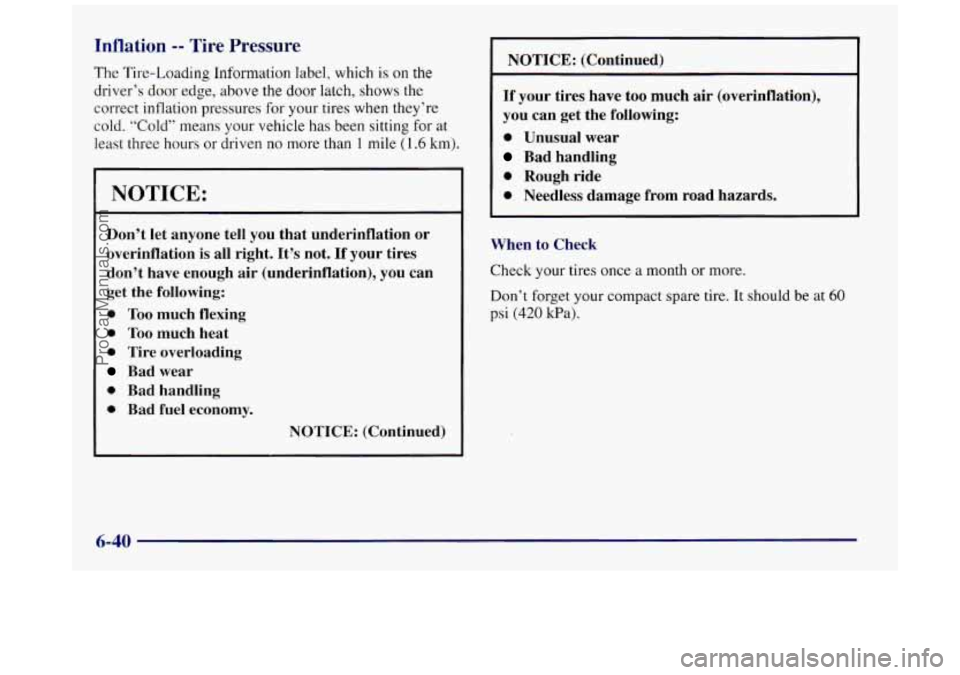
Inflation -- Tire sure
The Tire-Loading Information label, which is on the
driver’s
door edge, above the door latch, shows the
correct inflation pressures for your tires when they’re
cold.
“Cold” means your vehicle has been sitting for at
least three
hours or driven no more than 1 mile (1.6 km).
-
NOTICE:
Don’t let anyone tell you that underinflation or
overinflation is all right. It’s not.
If your tires
don’t have enough air (underinflation), you can
get the following:
0 Too much flexing
0 Too much heat
0 Tire overloading
Bad wear
0 Bad handling
0 Bad fuel economy.
NOTICE: (Continued) NOTICE: (Continued)
If your tires have too much air (overinflation),
you can get the following:
0 Unusual wear
Bad handling
0 Rough ride
0 Needless damage from road hazards.
When to Check
Check your tires once a month or more.
Don’t forget your compact spare tire. It should be
at 60
psi (420 kPa).
6-40
ProCarManuals.com
Page 317 of 422

How to Check
Use a good quality pocket-type gage to check tire
pressure. You can’t tell if your tires are properly inflated
simply by looking at them. Radial tires may
look
properly inflated even when they’re underinflated.
Be sure
to put the valve caps back on the valve stems.
They help prevent leaks by keeping out dirt and moisture.
Tire Inspection and Rotation
Tires should be rotated every 6,000 to 8,000 miles
(10 000 to 13 000 km). Any time you notice unusual
wear, rotate your tires as soon as possible and check
wheel alignment. Also check for damaged tires or
wheels. See “When It’s Time for New Tires” and
“Wheel Replacement” later in this section for
more information.
The purpose of regular rotation is to achieve more
uniform wear for
all tires on the vehicle. The first
rotation is the most important. See “Scheduled
Maintenance Services” in the Index for scheduled
rotation intervals. When
rotating your tires, always use the correct rotation
pattern shown here.
Don’t include the compact spare tire in your tire rotation.
After the tires have been rotated, adjust
the front and
rear inflation pressures as shown on the Tire-Loading
Information label. Make certain that all wheel nuts are
properly tightened. See “Wheel Nut Torque” in the Index.
ProCarManuals.com
Page 381 of 422
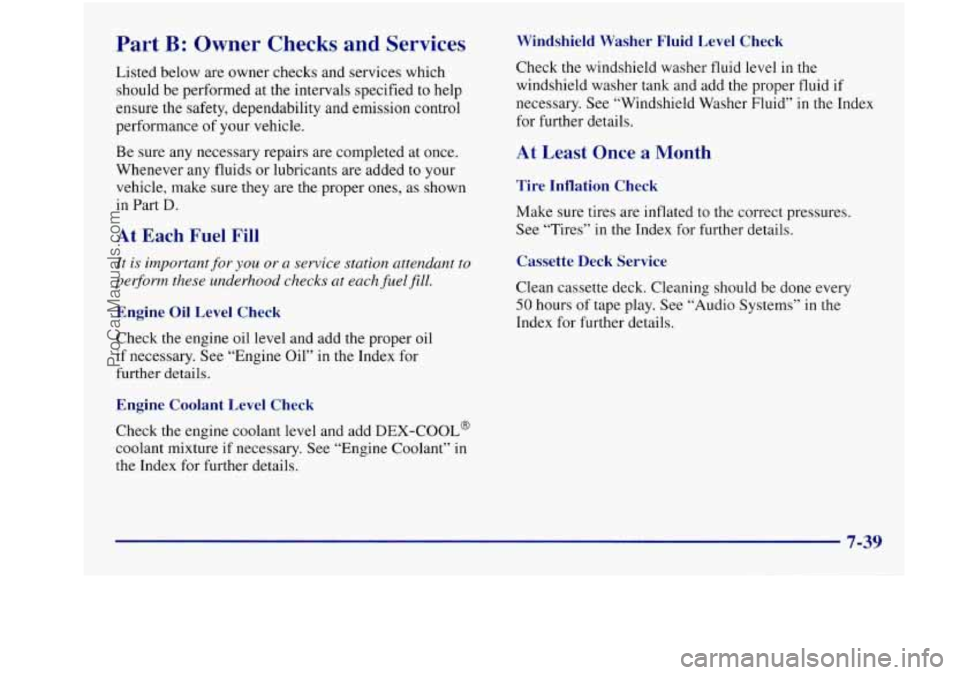
Part B: Owner Checks and Services
Listed below are owner checks and services which
should be performed at the intervals specified to help
ensure the safety, dependability and emission control
performance
of your vehicle.
Be sure any necessary repairs are completed at once.
Whenever any fluids or lubricants are added to your
vehicle, make sure they are the proper ones, as shown
in Part
D.
At Each Fuel Fill
It is important for you or a service station attendant to
pegown these underhood checks at each
fuel fill.
Engine Oil Level Check
Check the engine oil level and add the proper oil
if necessary. See “Engine Oil” in the Index for
further details.
Engine Coolant Level Check
Check the engine coolant level and add DEX-COOL@
coolant mixture if necessary. See “Engine Coolant” in
the Index for further details.
Windshield washer Fluid Level Check
Check the windshield washer fluid level in the
windshield washer tank and add the proper fluid if
necessary.
See “Windshield Washer Fluid” in the Index
for further details.
At Least Once a Month
Tire Inflation Check
Make sure tires are inflated to the correct pressures.
See “Tires” in the Index for further details.
Cassette Deck Service
Clean cassette deck. Cleaning should be done every
50 hours of tape play. See “Audio Systems” in the
Index for further details.
7-39
ProCarManuals.com
Page 417 of 422
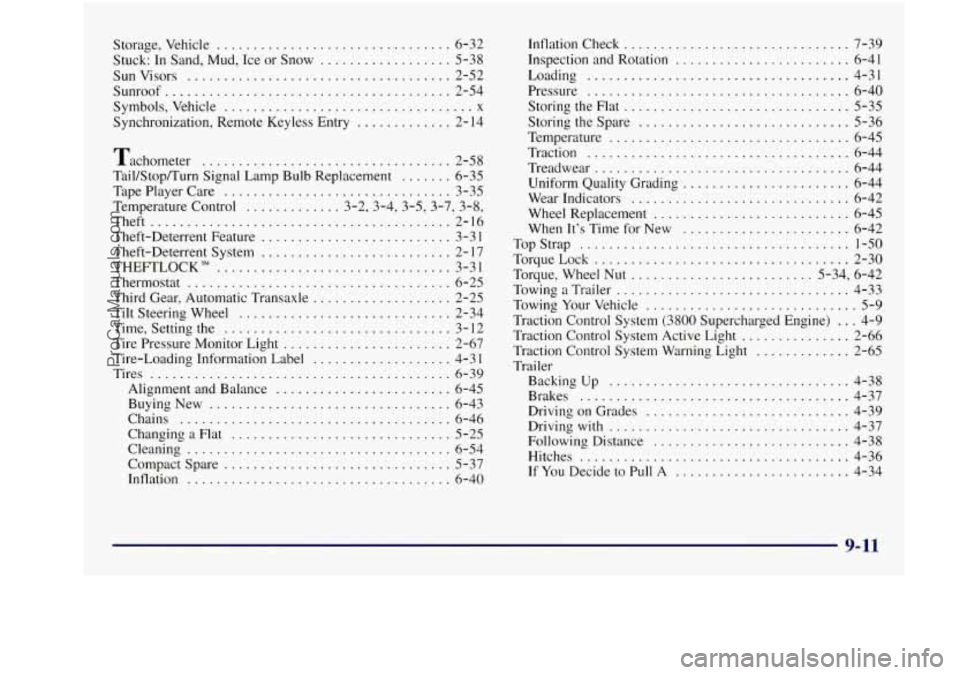
Storage. Vehicle ................................ 6-32
Stuck: In Sand. Mud. Ice or Snow
.................. 5-38
Sun Visors
.................................... 2-52
Sunroof
....................................... 2-54
Symbols. Vehicle
.................................. x
Synchronization. Remote Keyless Entry ............. 2- 14
Tachometer .................................. 2-58
Tail/Stop/Turn Signal Lamp Bulb Replacement
....... 6-35
TapePlayerCare
............................... 3-35
Temperature Control
............. 3-2. 3.4. 3.5. 3.7. 3.8.
Theft
......................................... 2-16
Theft-Deterrent Feature
.......................... 3-3 1
Theft-Deterrent System .......................... 2- 17
Thermostat
.................................... 6-25
Third Gear, Automatic Transaxle
................... 2-25
Tilt Steering Wheel
............................. 2-34
Time. Setting the
............................... 3- 12
Tire Pressure Monitor Light
....................... 2-67
Tire-Loading Information Label
................... 4-3 1
Tires ......................................... 6-39
Alignment and Balance
........................ 6-45
BuyingNew
................................. 6-43
Chains
..................................... 6-46
Changing
a Flat .............................. 5-25
Cleaning .................................... 6-54
Compact Spare
............................... 5-37
Inflation
.................................... 6-40
THEFTLOCK" ................................. 3-31 Inflation Check
............................... 7-39
Inspection and Rotation
........................ 6-41
Loading
.................................... 4-31
Pressure
.................................... 6-40
Storing the Flat
............................... 5-35
Storing the Spare
............................. 5-36
Temperature
................................. 6-45
Traction
.................................... 6-44
Treadwear
................................... 6-44
Uniform Quality Grading
....................... 6-44
Wear Indicators
.............................. 6-42
Wheel Replacement
........................... 6-45
When It's Time for New
....................... 6-42
TopStrap
..................................... 1-50
TorqueLock
................................... 2-30
Torque. Wheel
Nut ......................... 5.34. 6.42
Towing
a Trailer ................................ 4-33
Towing Your Vehicle
............................. 5-9
Traction Control System (3800 Supercharged Engine)
... 4-9
Traction Control System Active Light
............... 2-66
Traction Control System Warning Light
............. 2-65
Trailer Backing
Up ................................. 4-38
Brakes
..................................... 4-37
Driving on Grades
............................ 4-39
Driving
with ................................. 4-37
Following Distance
........................... 4-38
Hitches
..................................... 4-36
If You Decide to Pull A ........................ 4-34
9-11
ProCarManuals.com